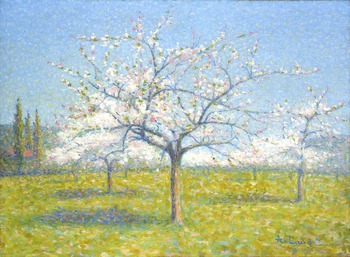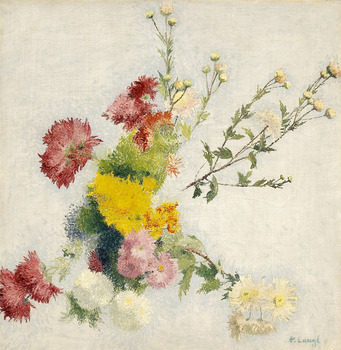Achille Laugé
Achille Laugé was born in Arzens in the Aude region of France, and became a follower of Neo-Impressionism. The son of well-to-do farmers who moved to Cailhau near Carcassonne, where he spent most of his life, Laugé began studies in Toulouse in 1878 and went to Paris in 1881. At the Ecole des Beaux-Arts he studied with Alexandre Cabanel and Jean-Paul Laurens. While at the École, Antoine Bourdelle, whom Laugé had known in Toulouse, introduced him to Aristide Maillol and the three maintained a long and fruitful friendship. In 1888, after seven years in Paris (including a term of military service), Laugé returned to the south and established himself at Carcassonne. Finally, in 1895, he returned to Cailhau where he spent the rest of his life.
Laugé?s time in Paris spanned the critical years from 1886 to1888 (Seurat's La Grande Jatte was first exhibited amidst much controversy in 1886) and his contact with Neo-Impressionism should not be underestimated. In 1894 he exhibited at the Salon des Indépendants, as well as at a Toulouse exhibition with de Bonnard, Maurice Denis, Sérusier, Roussel, Toulouse-Lautrec and Vuillard. In addition, he held several one-man shows in Paris from 1907-1930.
It was after his departure from Paris that Laugé developed his divisionist technique, following the lead of Seurat and the Pointillists. The technique consists in juxtaposing small strokes of primary color on the canvas in such a way that the ?optical mix,? traditionally created by mixing colors on the palette, is achieved instead by the operation of the viewer?s eye at a certain distance from the painting. Although Laugé never adopted Seurat?s scientific attitude, his interest in the primacy and division of color resulted in work with a vivid, translucent palette. From 1888 until about 1896, Laugé composed his pictures with small points of color. At the end of the century he abandoned the dots and dabs and painted his landscapes, portraits, and still lifes with thin, systematically placed strokes resembling crosshatching. After 1905 he applied his pigments more freely, with enlarged strokes and thick impasto that brought him closer to a traditional impressionist technique whilst maintaining his ability to paint the translucence of southern light.
Select Bibliography:
Pointillisme: sur les traces de Seurat. Fondation de l?Hermitage, 1998.
Daulte, François, Oscar Ghez, and Ezio Gribaudo. L?Aube du Xxe siècle: Néo-Impressionistes et autour du Néo-Impressionisme. Geneva: Petit Palais, 1968.
Tamburini, Nicole. Achille Laugé, le point la ligne, la lumière. Silvana Editorial, Milan, 2009.
Selected Museum Collections:
Musée de Carcassonne; Musée de Grenoble; Indianapolis Museum of Art, The Holliday Collection, Indiana; Limoux, Musée Petiet; Montauban, Musée Ingres; Montpellier, Musée Fabre; Morlaix; Paris, Musée National d'Art Moderne; Perpignan, Musée Hyacinthe Rigaud; Toulouse, Musée des Augustins
Exhibitions:
Achille Astre (1907), Alvin Beaumont, Paris (1911), Nunès et Fiquet, Paris (1919), Bernheim-Jeune, Paris (1923), Georges Petit, Paris (1927), Galerie de la Renaissance (1929), René Zevy (1930), Musée de Limoux (1958), Musée des Augustins, Toulouse (1961) [with Bourdelle and Maillol], Marcel Flavin (1966), Kaplan Gallery, London (1966), Hammer Galleries, New York (1967), Le Musée des Beaux-Arts de Carcassonne, Le Musée Petiet de Limoux et Le Musée de la Chartreuse de Douai, ? Achille Lauge, le point, la ligne, la lumiere (2009-2010)




